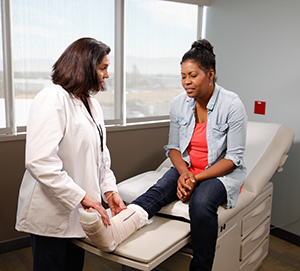Charcot foot is also called diabetic foot. The only way to stop the progression of it is to stay off the foot long enough for it to heal. Your healthcare provider will prescribe treatment to help healing.
Staying non-weight-bearing
While fractures are healing, it is crucial that you keep your weight off your foot. This is called non-weight-bearing. Your healthcare provider may ask you not to walk at all. Or they may prescribe a special device such as crutches. Remember: You often don’t feel pain with Charcot foot. So even if you feel fine, stay off your foot until your provider says it’s OK.
Using special devices
Special devices may help you keep weight off your foot. That way, your bones can heal smoothly. A wheelchair, crutches, or brace may be prescribed alone or with a cast. A Charcot restraint orthotic walker (CROW) may be prescribed. This is a custom rigid boot. It lets you keep putting weight on your foot. But it also protects your foot. Other devices may be prescribed to help you keep your foot raised while at home. An elastic bandage wrap or special stocking may also be advised. This compresses your foot to reduce swelling and aid healing.
Using custom footwear
Once your foot has healed, you may be fitted for custom shoes or inserts (orthoses). Custom footwear is specially made to fit the shape of your foot. This can help prevent ulcers caused by the rubbing from store-bought shoes. If custom footwear doesn't stop ulcers from forming, surgery may be needed to correct the deformity causing the ulcers.
It's important to look at your feet carefully every day. This includes looking between your toes and at the bottom of your feet. Call your healthcare provider right away if any area on your foot shows irritation or stays red for more than 30 minutes after you take off a special device such as a CROW or a brace.


